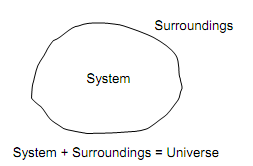System, Surroundings and the Boundary
The cautious and precise definition of the system by means of its boundaries is of greatest significance in resolving problems in thermodynamics. It is equivalent to isolate a free body in statics for a force balance.
Any arranged and particular collection of matter, whose behavior is being examined, is termed as the thermodynamic system, or just system, for brief; this is shown in the figure below. All other matter which is outside is termed as the surroundings or atmosphere. The system and the surroundings altogether build up the universe.

Figure: Definition of System
The boundary totally encloses the system and divides it from the surroundings. The boundary might be a material envelope or a substantial and visible interface among the system and its surroundings, as for illustration, the piston face and within cylinder walls in an automobile engine enclosing the gas in the cylinder. The boundary might also be an imaginary closed surface that contains the collection of matter under consideration; as for illustration, the imaginary closed surface surrounding a small volume of a fluid inside a larger volume of fluid.
No matter crosses the boundary of a system, by statement. Frequently the system will change shape and position, though the boundary then moves therefore always to hole the similar collection of matter. It means that a system has constant mass.